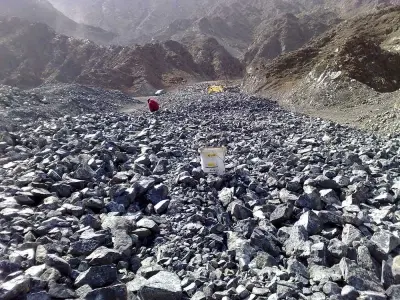Minerals Prices in Georgia
Georgia is one of the countries on the border of Western Asia and Eastern Europe. Scientists have identified over 4000 minerals of the earth's crust. The most important business sectors in Georgia are industrial, agriculture, tourism and construction. Substances that are formed based on natural processes are called minerals. Georgia's position on the road to Europe and its strategic situation and tax laws in the field of foreign investment are considerable. Minerals can be identified by their physical properties, such as hardness, color, appearance (luster) and odor
Add your import and export orders to this list
Warning: Undefined variable $formTitle in /home/anbar/domains/anbar.asia/anbar/inc/html/desktop/orderform.php on line 10
Warning: Undefined variable $marketName in /home/anbar/domains/anbar.asia/anbar/inc/html/desktop/orderform.php on line 12
Warning: Undefined variable $location in /home/anbar/domains/anbar.asia/anbar/inc/html/desktop/orderform.php on line 12
If you want to trade in the , please join in Anbar Asia. Your order will be shown here, so the traders of contact you

Georgia is a developing country with. Some minerals can be detected by a little more features than the naked eye. Imports from Georgia to Iran are limited to certain products, one of the most important of which is the import of meat from Georgia. Providing quality material has a huge impact on your reputation as a trader
- Georgia Cassitrite Market
- Georgia Chalcopyrite Market
- Georgia Coal Market
- Georgia Sphalerite Market
- Georgia Galena Market
- Georgia bauxite Market
- Georgia Hematite Market
- Georgia Chromite Market

Georgians speak Georgian. Georgia is one of the oldest and most original languages in the world, so it is said that this language can be considered one of the ten languages that humans first spoke. Their script is also derived from the originality of the language and is known as Georgian script.
Read More ...
Chromite is found as stone in nature. This stone is also known as chromite and contains chromium oxide with the formula FeCr2O4. Chromite occurs in mineral deposits and veins and may be found in the ground as small particles or larger deposits. Accumulations of chromite are found in some regions of the world including South Africa, Albania, Kazakhstan, Turkey and India.
Read More ...Statistics and information on the nonfuel mineral commodities produced in Georgia. 2016-2017 data for Georgia are summarized in this web page. Georgia leads in the production of fuller’s earth, kaolin, and iron oxide pigments. Minerals Yearbook Volume I -- Metals and Minerals. Mineral Yearbook Volume II - Georgia chapters. The following data table gives nonfuel mineral commodity production data for Georgia extracted from Table 5 in the 2017 Minerals Summary. 1Includes data from the commodity chapters published in the Minerals Yearbook as they were completed and released through December 2020.
Read More ...
Georgia is located in southwestern Asia between Russia and Turkey. From 1921 to 1991, Georgia was part of the USSR. On gaining independence, Georgia faced problems ranging from political instability and corruption to public discord. In 2008, the five-day conflict between Georgia and Russia led to Russia recognizing the independence of Abkhazia and South Ossetia. Recently, top foreign policy goals have been joining the EU and NATO. GDP as of 2017 is $15. 1% of all exports in Georgia. The natural resources of Georgia include manganese deposits, iron ore, copper, minor coal and oil deposits. Mining experts state that Georgia was once known to possess one of the world's richest manganese deposits in the Sachkhere and Tchiatura regions. Georgia has traditionally relied on imports for its residential and industrial needs. Georgia stopped importing natural gas from Russia in 2007, instead favoring Azerbaijan. Recent discoveries of natural gas in the country will no doubt help eliminate the issue of dependence on foreign natural gas and hydrocarbons and improve the economy of the country. The map of Georgia. The Chiatura manganese ore mine is the largest source of manganese in Georgia and is one of the largest in the world. The strategic location of Georgia between Europe and Asia has become an advantage to the nation making it a transit point for gas, oil, and other commodities. Currently, a major focus for the Georgian government is the exploration and development of its onshore and offshore oil and gas reserves through the Georgian Oil and Gas Corporation (GOGC). The Georgian government is now open to privatization and free markets. Experts believe that all these changes will certainly enable Georgia to attract foreign investment to its mining sector and ensure that its unexploited mineral deposits are fully utilized to generate revenue in the coming years. Georgia: Mining, Minerals and Fuel Resources. "Georgia: Mining, Minerals and Fuel "Georgia: Mining, Minerals and Fuel Georgia: Mining, Minerals and Fuel Resources.
Read More ...
Statistics and information on the nonfuel mineral commodities produced in Georgia. 2016-2017 data for Georgia are summarized in this web page. Georgia leads in the production of fuller’s earth, kaolin, and iron oxide pigments. Minerals Yearbook Volume I -- Metals and Minerals. Mineral Yearbook Volume II - Georgia chapters. The following data table gives nonfuel mineral commodity production data for Georgia extracted from Table 5 in the 2017 Minerals Summary. 1Includes data from the commodity chapters published in the Minerals Yearbook as they were completed and released through December 2020.
Read More ...
Kaolin deposits in middle Georgia resulted from the erosion of deeply weathered crystalline rocks in the Piedmont Plateau, which were deposited along Georgia’s Fall Line. This occurred between 50 and 100 million years ago during the Cretaceous and Tertiary geological time periods, a time when the waters of the Atlantic Ocean covered much of Georgia’s Coastal Plain. Almost 80 percent of the kaolin produced in Georgia is used in filling and coating: fine publication papers, light-weight catalog papers, and consumer product packaging. More than 4,400 Georgians are employed in the mining and processing of kaolin, making kaolin the state’s most important mineral industry - with direct payroll and employee benefits exceeding $232 million annually. Additionally, in 1992, $103 million was paid to hundreds of other Georgians who work in businesses serving the kaolin industry. The kaolin industry provides steady employment for a largely rural part of middle Georgia. In addition, the export activities of the industry are a major source of revenue for Georgia’s Port of Savannah. The overall economic impact of the kaolin industry on Georgia is estimated at $771 million in 1992. Georgia’s kaolin producers generate approximately $120 million each year in local, state and federal taxes. Economists estimate that the total payroll effect exceeds $470 million annually as payroll dollars are spent and recirculated in communities in middle Georgia and throughout the state. By continuing to invest in Georgia, the kaolin industry is working to maintain its leadership role in developing new kaolin-based products for worldwide markets.
Read More ...
Georgia is located in southwestern Asia between Russia and Turkey. From 1921 to 1991, Georgia was part of the USSR. On gaining independence, Georgia faced problems ranging from political instability and corruption to public discord. In 2008, the five-day conflict between Georgia and Russia led to Russia recognizing the independence of Abkhazia and South Ossetia. Recently, top foreign policy goals have been joining the EU and NATO. GDP as of 2017 is $15. 1% of all exports in Georgia. The natural resources of Georgia include manganese deposits, iron ore, copper, minor coal and oil deposits. Mining experts state that Georgia was once known to possess one of the world's richest manganese deposits in the Sachkhere and Tchiatura regions. Georgia has traditionally relied on imports for its residential and industrial needs. Georgia stopped importing natural gas from Russia in 2007, instead favoring Azerbaijan. Recent discoveries of natural gas in the country will no doubt help eliminate the issue of dependence on foreign natural gas and hydrocarbons and improve the economy of the country. The map of Georgia. The Chiatura manganese ore mine is the largest source of manganese in Georgia and is one of the largest in the world. The strategic location of Georgia between Europe and Asia has become an advantage to the nation making it a transit point for gas, oil, and other commodities. Currently, a major focus for the Georgian government is the exploration and development of its onshore and offshore oil and gas reserves through the Georgian Oil and Gas Corporation (GOGC). The Georgian government is now open to privatization and free markets. Experts believe that all these changes will certainly enable Georgia to attract foreign investment to its mining sector and ensure that its unexploited mineral deposits are fully utilized to generate revenue in the coming years. Georgia: Mining, Minerals and Fuel Resources. "Georgia: Mining, Minerals and Fuel "Georgia: Mining, Minerals and Fuel Georgia: Mining, Minerals and Fuel Resources.
Read More ...
https://www.azomining.com/Article.aspx?ArticleID=238
https://gallery.usgs.gov/centers/nmic/mineral-industry-georgia

